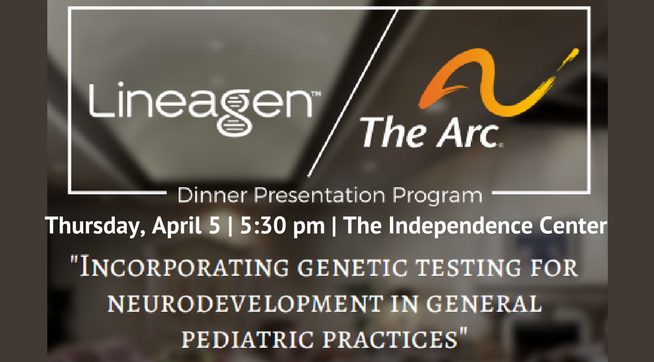The Arc Pikes Peak Region is pleased to partner with Lineagen, a company that provides genetic testing for children with autism and/or developmental delay, for a special educational dinner for general pediatricians. This complimentary dinner presentation will discuss how to incorporate genetic testing for neurodevelopment in general pediatric practices, and will help “minimize fear and uncertainty in incorporating clinical genetic testing for the general population.”
The presentation will be given by Kristina Kocsis, MS, certified and licensed genetic counselor, with a special question and answer time with Dr. Paul Wexler, Clinical Professor, Division of Genetics/Dept. of Pediatrics, Univ. of Colorado/The Children’s Hospital.
WHAT: Lineagen has partnered with The Arc Pikes Peak Region to provide genetics education to general pediatricians.
WHEN: Thursday, April 5, 2018 | 5:30 pm – 6 pm – Meet & Greet | 6 pm – 7 pm – Dinner Presentation
WHERE: The Independence Center, 729 S. Tejon St., Colorado Springs, CO 80903, Hershey/Roberts Conference Room
RSVP ONLINE: my.lineagen.com/thearc
Want to learn more? Check out the Genetic Testing Q&A video below with Laila Andoni, MS, Certified and Licensed Genetic Counselor.
Genetic Testing FAQ
Author: Laila Andoni, MS, Certified and Licensed Genetic Counselor
Genetic Background
Each of our bodies are made up of trillions of cells that perform the many microscopic tasks of life. Within each cell is a set of all of our genetic information, which is packaged in structures called chromosomes. Chromosomes are made up of DNA, and along each chromosome, written in letters of DNA, are many genes. Genes encode proteins, which perform specific functions related to growth and development. In this way, our genes act like individual instructions. In general, the cells of our bodies each have 46 chromosomes that come in 23 pairs. Each person receives one set of chromosomes from their mother, and the other is from their father. The first 22 pairs are the same in males and females and are called the autosomes. The last pair differs in males and females and is called the sex chromosomes. Females have two X chromosomes and males have one X and one Y chromosome. When a piece of genetic material is altered, it can impact development and lead to medical symptoms. Genetic testing is often ordered when a provider suspects a genetic change is the underlying cause of a person’s symptoms.
Does genetic testing diagnose someone with autism or intellectual or developmental disabilities?
While many genetic conditions may explain the cause of a person’s symptoms, it is important to note that autism and intellectual disabilities are clinical diagnoses, which are made based on features, behavior, and development.
Since genetics often contributes to the development of autism spectrum disorders, intellectual disabilities, and developmental delays, genetic testing is frequently ordered to help providers and parents better understand what is causing these symptoms, as well as whether a child is at risk for additional health or developmental concerns. A genetic diagnosis can help health care providers, therapists, educators, and families to better tailor care.
Some parents and providers feel a child is “borderline” and may have some features of autism or developmental disability. A genetic test may explain those features, but won’t necessarily confirm that a person does or does not have autism. In some cases, having a genetic diagnosis may qualify a person for additional therapies or services.
How much of autism is genetic?
Autism has a very strong genetic basis. Researchers believe that 60-90% of people with autism have contributing genetic factors. However, the genetics of autism is very complex, and not all factors are well understood yet or have testing available.
Our development is complex and involves the interactions of many different genes with aspects of our environment. The genetics of autism is still being studied, and our understanding of this complicated area of genetics continues to expand at a rapid pace. Even in children who receive a normal genetic test result on CMA, it is still likely that genetics is playing a role. For families who have a child with an autism spectrum disorder, there is about a 19% chance (around one in five) to have another child with autism.
What genetic testing is available?
For people with autism or a spectrum of intellectual and developmental disabilities, the American College of Medical Genetics recommends a test called chromosome microarray analysis (CMA) as a first step to look for a genetic cause. This test is designed to look for pieces of extra or missing genetic information and can identify hundreds of genetic conditions. CMA finds extra or missing pieces of genetic material about 30% of the time. In some cases, results are clear and a diagnosis is made. In other cases, a result may be rare and we may not know if it is contributing to a person’s symptoms. There are other types of genetic changes that could contribute to autism and other developmental symptoms that would not be detected by CMA. For example, small spelling errors in a gene that can lead to symptoms are detected by a different type of genetic testing called sequencing.
How can genetic testing change medical care for someone with autism, intellectual, or developmental disabilities?
In many cases, having a diagnosis of a genetic condition can give medical providers information needed to personalize care for a child. Some genetic conditions that cause autism or developmental disabilities can also increase the risk for other health concerns, like seizures, heart defects, vision or hearing loss, growth issues, and others. A person with a genetic condition will typically not have all of the features that can be caused by that condition, but may have a higher risk for these things than an average person. This often prompts evaluations with other medical specialists, and sometimes additional types of screening tests and treatments. There may also be more appropriate developmental therapies for that child. The types of recommendations vary quite a bit depending on the diagnosis. A genetic diagnosis may also personalize information for the family, such as the chance for the parents to have another child with the same condition or whether other family members may be at risk for health conditions.
For example, take a three-year-old girl with speech delay and a new diagnosis of autism spectrum disorder. She is receiving ABA therapy and speech therapy. Her pediatrician recommends genetic testing to determine if there is an underlying cause for autism. The test comes back showing that she has extra genetic material causing a condition called 17q12 duplication syndrome. Now the pediatrician is aware of an increased chance for seizures, a heart defect, and kidney or eye abnormalities. She can be referred to neurology because of the chance for seizures, cardiology to look at her heart, have a kidney ultrasound, and an eye exam. It is found that she has a small hole in her heart called a ventricular septal defect. Now the cardiologist can manage this small hole in the heart- watching to see if it is causing symptoms and closing the hole surgically if it does not close spontaneously on its own. No one would have known to do these things if they did not know about the underlying cause of autism- the genetic condition.
If a genetic change is found in my child, what would it mean for me and other family members?
If a genetic condition is found in a child, it may be inherited from a parent or brand new in that person, which we call de novo. Depending on the type of result, testing of other family members may help figure out if a genetic condition is inherited and potential health risks to other family members. Whether a genetic change is inherited or brand new, it is not caused by something a parent does or does not do.
Sometimes other family members may have some of the same symptoms as the child, which can offer clues about whether a condition is inherited. Sometimes family members will have mild symptoms or won’t have any symptoms at all, but they carry the exact same genetic change. If a genetic change is found in a child, the only way to know for sure if it was inherited is to test the parents. This helps to clarify if there are health risks for other family members, like parents and siblings. An evaluation with a medical geneticist can help make a plan for testing.
What happens to the genetic material after the testing?
Use of genetic material after testing depends on a laboratory’s policy. Some will store genetic material for future use in case further testing needs to be ordered. Some hold on to it for research purposes or quality control, in which the genetic material will typically no longer be linked to the person’s identifying information anymore. Other labs may routinely destroy genetic material after a certain period of time after testing. To learn more or if you have a specific request for the handling of your genetic material, please contact the laboratory that is running your test. Lineagen would be happy to work with you to ensure you are comfortable with how your genetic material is handled after testing.
Subscribe To Our Newsletter and SMS Reminders
The best way to ensure that you receive our newsletter, our event invitations, SMS reminders and other important information is to become a member of The Arc of the Pikes Peak Region.
The best way to ensure that you receive our newsletter, our event invitations, and other important information is to become a member of The Arc of the Pikes Peak Region.


